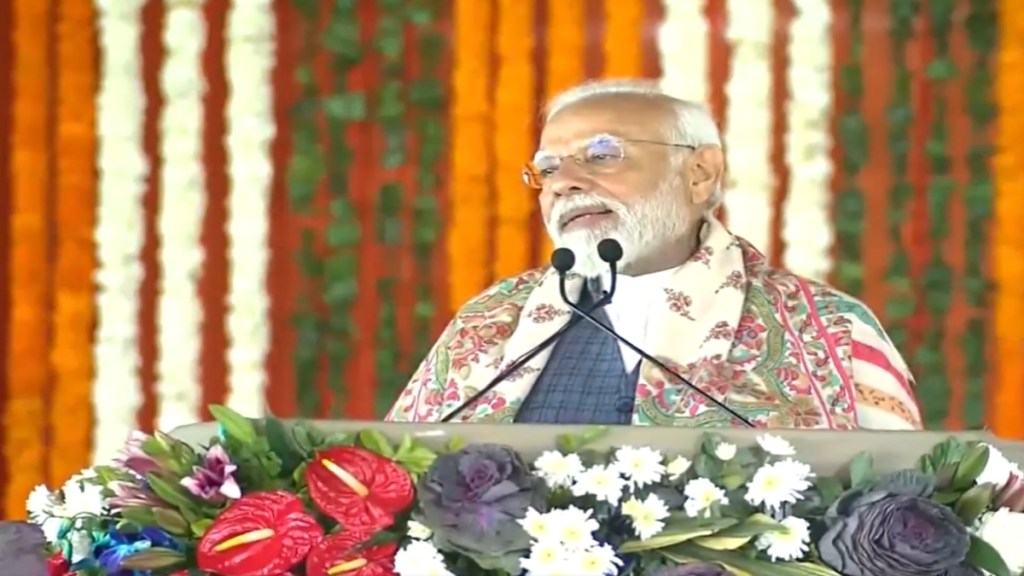By Farooq Wani
Prime Minister Narendra Modi’s latest visit to Jammu on February 20 marks yet another milestone in his government’s “Sab Ke Saath, Sab ke Vikas, Sabka Vishwaas, Sabka Prayaas” mission. Like all previous visits, it amplified the centre’s firm commitment to strengthen its bond with the people of the union territory of J&K and the prime minister’s promise of ensuring development with stability in this region.
Timed well and shorn of ceremonial content, Modi’s visit operationalised several development-linked projects involving an investment of a whopping Rs 32, 000 crores. It was a visit primarily designed to further improve Jammu’s socio-economic infrastructure in key sectors like health care, transportation, rail, road, aviation and petroleum as well as other civic amenities.
The Prime Minister also inaugurated the campus of an Indian Institute of Management in Jammu, one of three that he did, the other two being in Bihar’s Bodh Gaya and Visakhapatnam in Andhra Pradesh. He also laid the foundation stone of projects worth Rs.13,375 crores, which include permanent campuses for three IITs, 20 Kendriya Vidyalayas and 13 Navodaya schools. The launchings of these projects were declared at a public function held at Jammu’s Maulana Azad Stadium.
The other engagements of the Prime Minister included distribution of appointment letters to about 1,500 new government recruits and an interaction with beneficiaries of various government schemes under the ‘Viksit Bharat Viksit Jammu’ program.
The inauguration of the All-India Institute of Medical Sciences (AIIMS) in Jammu, in particular, has to be viewed as a strategic achievement that will give a much-needed boost to the region’s healthcare infrastructure. AIIMS Jammu, spread across 227 acres, has been built at a cost of over Rs.1,600 crores and is expected to address the diverse needs of both patients and the medical fraternity.
This commitment to key socio-economic infrastructure as well as intent to strengthen connectivity with the local citizens is both missionary and visionary in the context of progress from bottom up. Inaugurating railway projects, laying foundation stones for road networks and a 40,000 square metre state-of-the-art airport terminal are definitely game-changers that will bring about progress through rapid transformation.
The inauguration of a new railway line from Banihal to Sangaldan via Khari and Sumberand the electrification of the Baramulla-Srinagar-Banihal-Sangaldan stretch (185.66 Km) is progress beyond measure and Jammu can now proudly claim that it is well on its way to a sustainable economic future.
Road connectivity has taken a giant leap forward with the construction of the 44.22-kilometre-long Jammu to Katra stretch that now forms a part of the Delhi-Amritsar-Katra Expressway. The upgradation of the Srinagar Ring Road into a four-lane project and activating plans to improve the Srinagar-Baramulla-Uri stretch of National Highway-01, the Kulgam and Pulwama bypasses on National Highway-444 will strengthen road infrastructure and connectivity further.
With the local economy in the UT of J&K predominantly dependent on tourism, investment in improving connectivity and travel logistics will bring in greater revenue making J&K’s economy comparable to those of other mainline states.
The foundation stone of the cutting-edge Common User Facility (CUF) petroleum depot in Jammu, a project valued at Rs 677 crores, is another progressive decision.
Developing and strengthening infrastructure aside, Modi’s Jammu visit was also high on political and counter-terrorism messaging. While addressing the people of Jammu, the issue of Article 370 abrogation was high on his list of priorities and he described controversial segments of the article as the “biggest hurdle” to the region’s development.
Mentioning the upcoming film on Article 370, Modi said it reflects the coming of a new J&K that no longer accepts “politics of dynasts”, or “politics of appeasement”, but is “blowing the bugle of development” for a better future.
He said the “Abrogation of Article 370 has gifted rights to women which they were deprived of earlier” and it was his belief that a developing J&K will soon attract greater world attention, something which couldn’t have been dreamt of in the pre-2014 period because of the wilful neglect shown by previous governments towards the people of J&K and to the nation’s defence personnel.
A transformed J&K, characterised by better infrastructure, new and thriving institutions and communities that are empowered has also ushered in an era of peace. Data released by the centre last month indicates that J&K has witnessed a 66 percent drop in terror-related incidents and an 81 percent drop in civilian-related killings since the scrapping of Article 370 on August 5, 2019.
Both Prime Minister Modi and Home Minister Amit Shah are on record as saying that J&K is transforming from a region “known for terrorism”, into a region viewed as a tourism and economic hub.
J&K Lt Governor Manoj Sinha has gone a step further by saying that terror incidents are down by 75 percent, and added that the days of terror recruitment and protest calendars are over. Decades of suffering, injustice, separatism, terrorism and corruption have ended, he added. Sinha described Modi as the “Architect of a New India and a New Jammu and Kashmir”.
In 2023, there were no reports of stone-pelting incidents or shutdowns, which wasn’t the case between 2000 and 2014. The financing of terror has virtually dried up and organisations spewing hatred and spouting terror lingo are few and far between.
The era of bomb blasts, firings, stone-pelting and shutdowns has been replaced by themes and actions that encourage education, healthcare, business management, industries and infrastructure.
The comprehensive transformation of J&K, the hustle and bustle of development seen in every corner of the UT is visible proof of visionary leadership for a present and a future that looks promising and bright.
The author is Editor Brighter Kashmir, Author, TV commentator, political analyst and columnist. Email: farooqwani61@yahoo.co.in
Disclaimer: Views expressed are personal and do not reflect the official position or policy of Financial Express Online. Reproducing this content without permission is prohibited.

